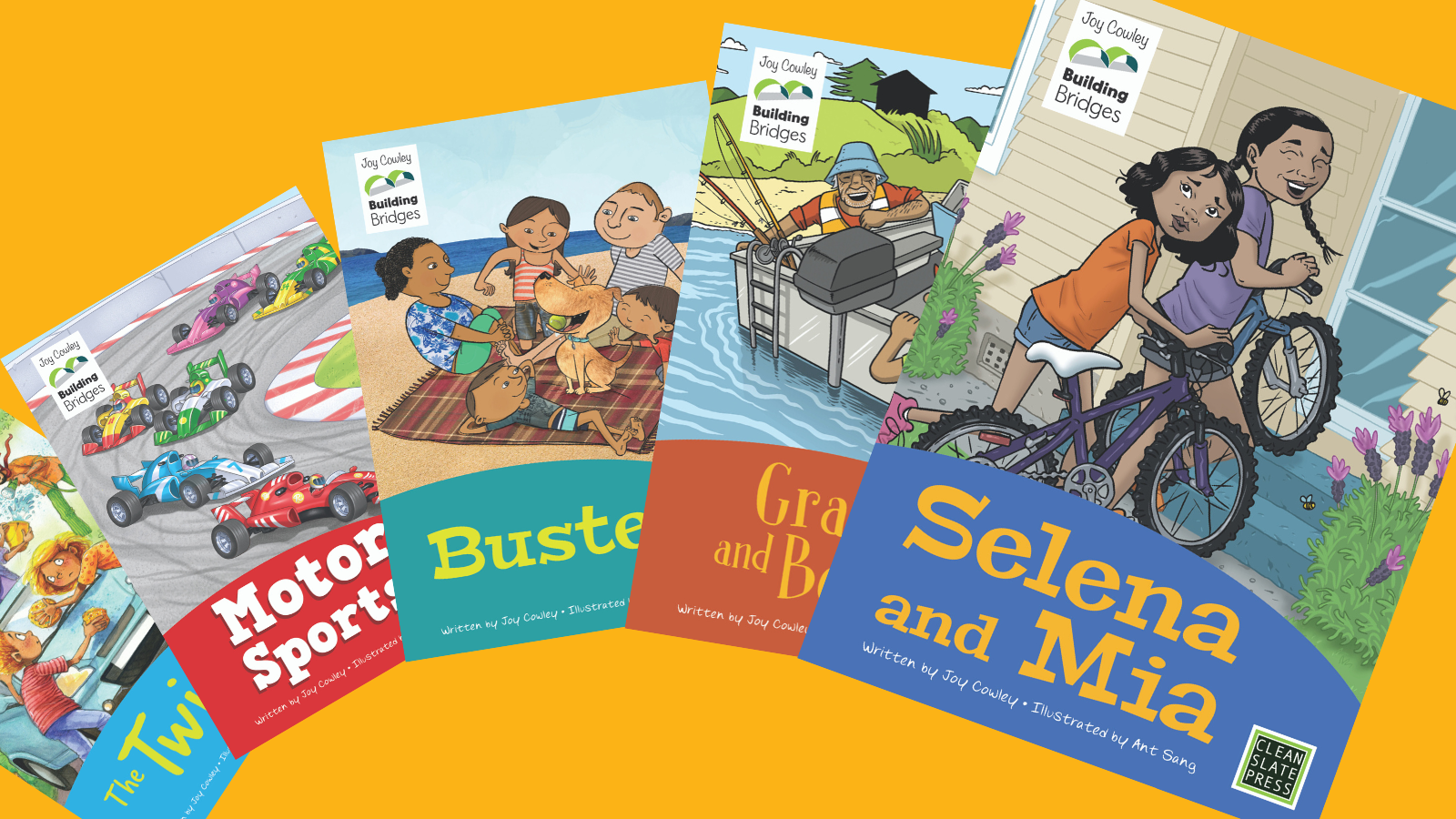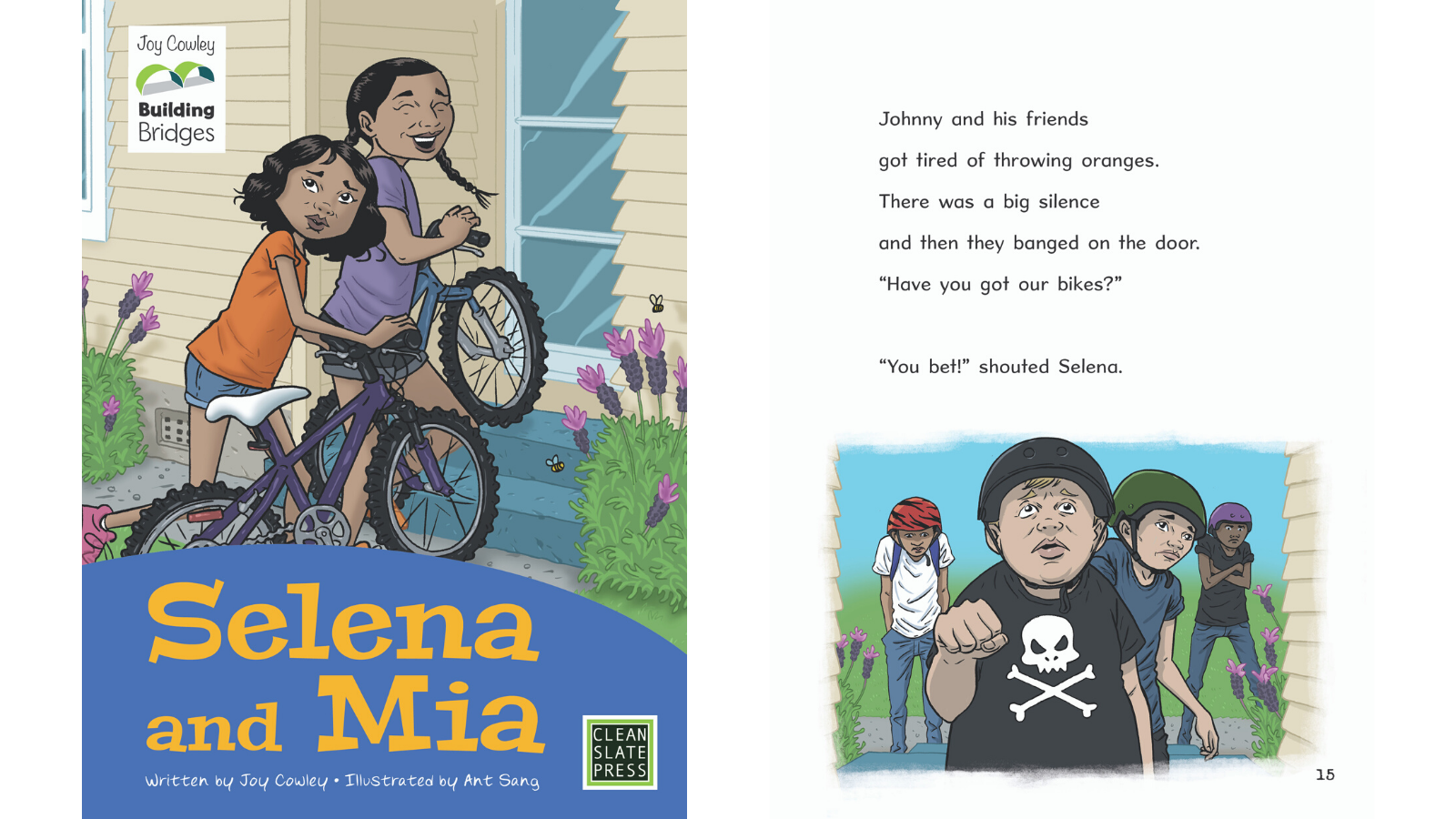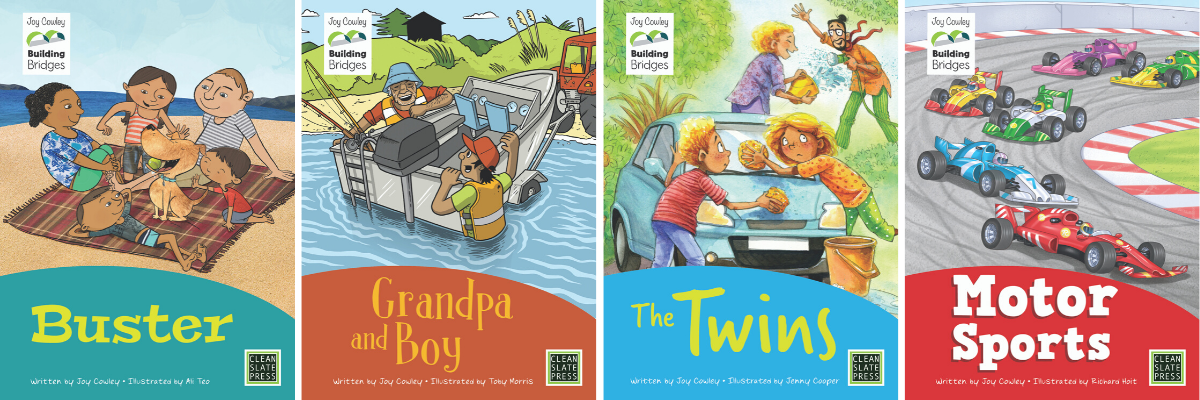Co-founder of The Sapling Jane Arthur has a long-standing interest in educational publishing – so when the opportunity came along to pick the brain of Clean Slate Press’ Frances McBeath, it was the perfect match. Read on to learn more about the ins and outs of the Joy Cowley Building Bridges series, first launched in 2019.

I’ve long been fascinated with educational publishing, the books and resources used in classrooms that you generally can’t buy in bookshops. To me, educational publishing is a mysterious blend of science, art and I don’t know – maybe secret herbs and spices?
Frances McBeath, the publishing and sales director of Clean Slate Press, agreed to demystify things for me, talking me through their Joy Cowley Building Bridges series for readers aged eight to 12 who are struggling with their literacy. These books are what is sometimes referred to as ‘high/low’ – sophisticated content yet simple language.
It’s really, really hard to write full, engaging stories with only a few words. It takes a long time – and knowledge and talent – to chip away the extraneous wording to reveal the essential parts of story, character, tone and setting. Joy Cowley is an expert at this sort of storytelling.
Jane: What’s the history of Clean Slate Press? And how did Joy Cowley get involved?
Frances: Clean Slate Press was started in 2005 by Sandy Roydhouse and myself, after working together for some time for another educational publishing company. We had a lot of fresh ideas and many years of publishing experience and the time was right to go out on our own.
Initially, we focused on the international market and sold our first three series on our first North American sales trip. This was a great boost to our confidence and we went on to pick up more customers in North America, Australia, and parts of Asia before deciding to also publish for the New Zealand market.
In 2007, we heard that Shortland Publications was closing down. This inspired us to write to Joy Cowley, outlining our experience, vision, and desire to be her educational publisher. Joy later told us that she was approached by four or five publishers with the same request. Joy chose Clean Slate Press and asked that we made our contract with her exclusive for the international market.
It is a great honour to work with Joy. She is hugely generous with her expertise and we have learned so much from her. It is also a great pleasure to work with her to publish books that resonate with so many New Zealand readers.
It is a great honour to work with Joy. She is hugely generous with her expertise and we have learned so much from her.
When and how did the Joy Cowley Building Bridges series come about?
The series has been brewing for some time. Reluctant readers are often given non-fiction to read, rather than fiction, in an effort to provide material that has not so obviously been produced for younger readers. This means, unfortunately, that the readers who most need to discover the delight and magic of story often miss out.
We knew there was a need for easy-to-read fiction texts that would appeal to older readers, so we asked Joy Cowley (who was once a struggling reader herself) if she’d be interested in writing them. She was very keen and took onboard that we primarily wanted these books for New Zealand schools and so we wanted a diverse range of characters that would be recognisably Kiwi. We told Joy that while seven and eight year olds would read these books, they needed to appeal to children as old as 12 as well.
Originally the plan was for 15 separate books, but we decided that by putting three connected short stories together we would achieve two important things. Firstly, the books would look like the chapter books that on-level readers use in class. This was very important to us as we strive to increase the reader’s confidence, not decrease it. In other words, we didn’t want to produce anything that looked like ‘baby books’ for struggling readers.
…the books would look like the chapter books that on-level readers use in class. This was very important to us as we strive to increase the reader’s confidence, not decrease it.
Secondly, reading the books would be pleasurable, thereby providing positive reinforcement to the reader. A short story is a lot less daunting to a reader than a chapter book. Plus the whole story is wrapped up in the time it takes to read one chapter, so a sense of achievement is gained by the reader at the end of each session. By putting three short stories together, we would still achieve our original aim.
The first five books in Joy Cowley Building Bridges were published in 2019.
Does Joy come up with the ideas for each book or do you give her the brief?
Joy comes up with all of her own ideas. One of the challenges with Joy Cowley Building Bridges was coming up with characters and scenarios that would lend themselves to three stories.
Occasionally, Joy would come up with two stories for a set of characters but then find that she couldn’t settle on a third scenario that she thought was strong enough. When that happened, those stories were put aside completely and Joy came up with something completely new.

How do you assess a piece of writing as being suitable for the curriculum level and age of reader? How do you decide what the vocabulary should be?
When we’re working with Joy Cowley she makes many of the decisions on vocabulary, sentence structure, and sentence length. She is an expert at writing to the required level so it makes our job very easy. We also undertake our own research when needed; for example, factors that contribute to readability for texts to be used with dyslexic readers.
When the books are nearly completed, with illustrations in place, we send them to our educational consultants for independent levelling and feedback. It’s important that the illustrations are in place before levelling as the text/picture match can affect the level.
The consultants take a number of factors into consideration, including the font, length of text, complexity of sentence structure, richness of vocabulary, complexity of concepts contained in the text, and the way that the illustrations strongly support the text. They also consult the NZ Curriculum and other series in the market before providing us with their levels.
The consultants take a number of factors into consideration, including the font, length of text, complexity of sentence structure, richness of vocabulary, complexity of concepts contained in the text, and the way that the illustrations strongly support the text.
The same educational consultants who provided the levelling for Joy Cowley Building Bridges also wrote the accompanying Teacher’s Notes that are available free on our website. We particularly like that there are separate Guided Reading notes for each of the three stories in each book and the varied follow-on Inquiry Focus/Activities that are included for each story.
How long does it take to produce each title – from first idea to printed book? What is involved?
It takes a long time to make a book, much longer than most people realise.
When working with Joy, the process is often sped up as the process of editing the raw manuscripts is more streamlined than normal. However, there are still many stages to go through once a manuscript is written, such as deciding on design specifications, page layouts, and text load per page; illustration briefs; illustrator selection; illustration roughs; numerous editorial checks; final art; early market responses; further editorial checks; and the printing process, which itself takes two months.
What design decisions are made to make the books dyslexia-friendly?
There were many design decisions made to increase the accessibility of the Joy Cowley Building Bridges titles. These included generous margins with line lengths limited to short phrases and a lot of clear space around the text. This is very different to how the text in an ‘on-level’ chapter book would be treated.
A number of fonts were considered and a large clear sans serif font was selected. We decided to use many illustrations so that there were no large blocks of unbroken text. We went with full-colour illustrations to increase the visual appeal of the books and provide more visual cues.
We went with full-colour illustrations to increase the visual appeal of the books and provide more visual cues.
We also made dyslexia-friendly decisions at printing by choosing matte cream-coloured paper rather than standard white high-gloss paper. These choices made the books more expensive to produce, but we wanted to be sure to be best-serving the needs of readers with dyslexia.
How do you choose the illustrators? Some of New Zealand’s top illustrators are used for this series.
As most of our publishing is for the international market, we use illustrators both from New Zealand and overseas. However, we wanted Joy Cowley Building Bridges to be firmly New Zealand and we also wanted to support local illustrators, so we made a decision to use premium New Zealand illustrators for this series.
We put a lot of thought into choosing our illustrators. It’s important to us that the illustrator’s style matches the story and it’s important that the illustrations help the reader make meaning from the text.
It’s important to us that the illustrator’s style matches the story and it’s important that the illustrations help the reader make meaning from the text.
When you’re making books for children to read to themselves rather than a picture book that an adult will read to a child, the illustrations need to convey information to help the child decode the text. This was particularly true for Motor Sports, where the details of the cars and the safety gear had to be just right. We knew Joy had written Motor Sports ‘for readers who like vehicles more than reading’ and that the text contains information as well as story, so we knew that accuracy was needed for the illustrations. We chose Richard Hoit to illustrate this book because we knew that he goes the extra mile on research time to make sure he gets everything right.
Jenny Cooper’s quirky style was perfect for the loveable family in The Twins and we knew that Ant Sang would bring out the coolness and attitude in Selena and Mia. We had never worked with Ali Teo or Toby Morris before, and they were right at the top of our ‘must-have’ list for Buster and Grandpa and Boy.
The trouble with wanting to use premium New Zealand illustrators only, is that they are always booked up on other projects. The need to meet deadlines is why we often turn to the larger international pool of illustrators. Some of our five chosen illustrators were booked up for many months, but we held firm on the illustrators we wanted, even though it meant delaying the release of the series. We’re glad we did this as we feel that every illustrator in the series is a perfect fit!

The covers of Buster, Grandpa and Boy, The Twins and Motor Sports, all written by Joy Cowley and illustrated by Ali Teo, Toby Morris, Jenny Cooper and Richard Hoit respectively.
How do you keep up-to-date with the NZ Curriculum and what schools want and need?
We keep a close eye on both the NZ Curriculum and what the market is telling us. We have a team of seven sales reps around the country who are in constant contact with schools. The reps let us know what teachers are asking for and they also provide us with feedback from schools on our resources.
We also keep our ear to the ground and engage with teachers as much as possible in an effort to keep up-to-date. It’s very interesting to hear what teachers think, and while it is impossible to keep everyone happy all of the time, we do receive very positive feedback from schools. One thing we kept hearing from schools and RT: Lits (Resource Teacher: Literacy) in particular was that there was a profound need for easy-to-read texts aimed at older students. Joy Cowley Building Bridges was created as a response to this need.
Has any of the feedback been used to plan further books in the series?
The feedback we’ve had from schools has been overwhelmingly positive. Teachers love that the stories are so carefully crafted and written by Joy Cowley; the New Zealand content, idioms, and recognisable settings; and the diversity of the family-based stories. Both teachers and students love the high-quality artwork and we’ve been told that students really enjoy and respond well to these books.
As soon as the books were released, we had schools and RT: Lits saying that they loved them and asking us to produce more. We keep hearing that the need is great, the books are very well-received by students, and can we please, please, please make more. So we are. We have five new Joy Cowley Building Bridges books in the early stages of production and we think that Joy Cowley Building Bridges 2 is going to be even better than the original set!

Jane Arthur
Jane Arthur's debut children's book, Brown Bird(PRH) was published in May 2024 to widespread acclaim. Jane is co-founder of The Sapling, co-owned and managed GOOD BOOKS, a small independent bookshop in Pōneke Wellington and has twice judged the NZ Book Awards for Children and Young Adults, in 2019 and 2020. Her debut poetry collection, Craven (VUP) won the Jessie Mackay Prize for best first book of poetry at the 2020 Ockham NZ Book Awards, and her second collection, Calamities!(THWUP) was longlisted for the Mary and Peter Biggs Award for Poetry in the 2024 Ockham Awards.



